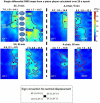High Density Surface Electromyography Activity of the Lumbar Erector Spinae Muscles and Comfort/Discomfort Assessment in Piano Players: Comparison of Two Chairs
- PMID: 34925054
- PMCID: PMC8671302
- DOI: 10.3389/fphys.2021.743730
High Density Surface Electromyography Activity of the Lumbar Erector Spinae Muscles and Comfort/Discomfort Assessment in Piano Players: Comparison of Two Chairs
Abstract
Introduction: At a professional level, pianists have a high prevalence of playing-related musculoskeletal disorders. This exploratory crossover study was carried out to assess and compare quantitatively [using high density surface electromyography (HDsEMG)], and qualitatively (using musculoskeletal questionnaires) the activity of the lumbar erector spinae muscles (ESM) and the comfort/discomfort in 16 pianists sitting on a standard piano stool (SS) and on an alternative chair (A-chair) with lumbar support and a trunk-thigh angle between 105° and 135°. Materials and Methods: The subjects played for 55 min and HDsEMG was recorded for 20 s every 5 min. For the quantitative assessment of the muscle activity, the spatial mean of the root mean square (RMS ROA ) and the centroid of the region of activity (ROA) of the ESM were compared between the two chairs. For the qualitative assessment, musculoskeletal questionnaire-based scales were used: General Comfort Rating (GCR); Helander and Zhang's comfort (HZc) and discomfort (HZd); and Body Part Discomfort (BPD). Results: When using the A-chair, 14 out of 16 pianists (87.5%) showed a significantly lower RMS ROA on the left and right side (p < 0.05). The mixed effects model revealed that both chairs (F = 28.21, p < 0.001) and sides (F = 204.01, p < 0.001) contributed to the mean RMS ROA variation by subject (Z = 2.64, p = 0.004). GCR comfort indicated that participants found the A-Chair to be "quite comfortable," and the SS to be "uncomfortable." GCR discomfort indicated that the SS caused more numbness than the A-Chair (p = 0.05) and indicated the A-Chair to cause more feeling of cramps (p = 0.034). No difference was found on HZc (p = 0.091) or HZd (p = 0.31) between chairs. Female participants (n = 9) reported greater comfort when using the A-Chair than the SS (F = 7.09, p = 0.01) with respect to males. No differences between chairs were indicated by the BPD assessment. Conclusion: It is concluded that using a chair with lumbar support, such as the A-chair, will provide greater comfort, less exertion of the ESM and less discomfort than the standard piano stool.
Keywords: back muscles; high-density sEMG; musculoskeletal questionnaire; piano players; surface electromyography.
Copyright © 2021 Aranceta-Garza, Russo, D’Emanuele, Serafino and Merletti.
Conflict of interest statement
FS was employed by company Montecatone Rehabilitation Institute S.p.A. The remaining authors declare that the research was conducted in the absence of any commercial or financial relationships that could be construed as a potential conflict of interest.
Figures




References
-
- Amaral Corrêa L., Teixeira Dos Santos L., Nogueira Paranhos E. N., Minetti Albertini A. I., Jr., do Carmo Silva Parreira P., Calazans Nogueira L. A. (2018). Prevalence and risk factors for musculoskeletal pain in keyboard musicians: a systematic review. Phys. Med. Rehabil. 10 942–950. 10.1016/j.pmrj.2018.04.001 - DOI - PubMed
-
- Beam C. A., Wieand H. S. (1991). A statistical method for the comparison of a discrete diagnostic test with several continuous diagnostic tests. Biometrics 47 907–919. - PubMed
-
- Bendix T., Biering-Sørensen F. (1983). Posture of the trunk when sitting on forward inclining seats. Scand. J. Rehabil. Med. 15 197–203. - PubMed
-
- Berque P., Gray H., McFadyen A. (2016). Playing-related musculoskeletal problems among professional orchestra musicians in scotland: a prevalence study using a validated instrument, the musculoskeletal pain intensity and interference questionnaire for musicians (MPIIQM). Med. Probl. Perform. Artists 31 78–86. 10.21091/mppa.2016.2015 - DOI - PubMed
LinkOut - more resources
Full Text Sources

